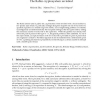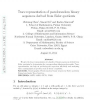106
click to vote
ALENEX
2016
9 years 1 months ago
2016
Exploiting geometric structure to improve the asymptotic complexity of discrete assignment problems is a well-studied subject. In contrast, the practical advantages of using geome...
115
click to vote
AAECC
2016
Springer
9 years 1 months ago
2016
Springer
We design in this paper the first attribute-based cryptosystems that work in the classical Discrete Logarithm, pairing-free, setting. The attribute-based signature scheme can be s...
AAI
2015
9 years 1 months ago
2015
This paper studies T-preorders than can be generated in a natural way by a single fuzzy subset. These T-preorders are called one-dimensional and are of great importance, since ever...
AAI
2015
9 years 1 months ago
2015
We propose a novel approach to music emotion recognition by combining standard and melodic features extracted directly from audio. To this end, a new audio dataset organized simil...
AAECC
2015
Springer
9 years 1 months ago
2015
Springer
We describe an algorithm for computing a finite, and typically small, presentation of the fundamental group of a finite regular CW-space. The algorithm is based on the constructi...
AAECC
2015
Springer
9 years 1 months ago
2015
Springer
The present paper investigates properties of quasi stable ideals and of Borel-fixed ideals in a polynomial ring k[x0, . . . , xn], in order to design two algorithms: the first on...
AAECC
2015
Springer
9 years 1 months ago
2015
Springer
The Rabin scheme used in public-key cryptosystem is here revisited with a focus limited to a few specific open issues. In particular, message decryption requires one out of four ...
AAECC
2015
Springer
9 years 1 months ago
2015
Springer
CIAC
2013
Springer
9 years 2 months ago
2013
Springer
In network activation problems we are given a directed or undirected graph G = (V, E) with a family {fuv (xu, xv) : (u, v) ∈ E} of monotone non-decreasing activation functions fr...
TACAS
2014
Springer
9 years 2 months ago
2014
Springer
Of special interest in formal verification are safety properties, which assert that the system always stays within some allowed region, in which nothing “bad” happens. Equival...





